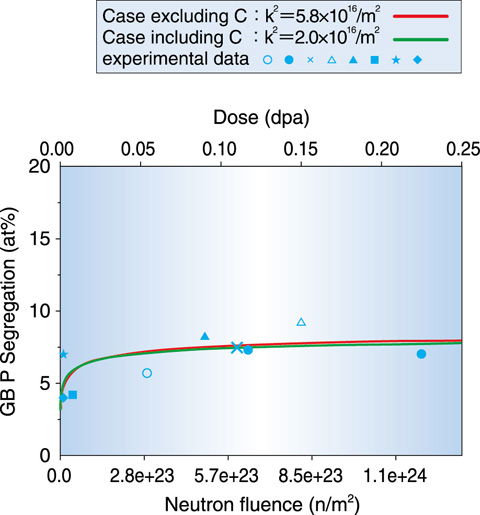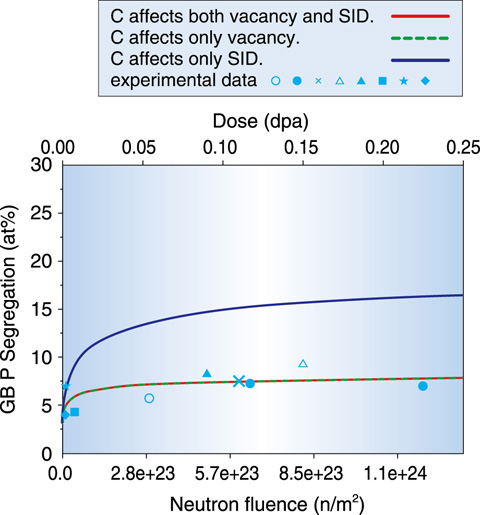
Fig.11-2 GB P segregation vs. dose

Fig.11-3 Influence of C on GB P segregation
Several impurity elements at grain boundaries (GBs) in steel cause degradation of the toughness of steel by weakening the cohesive strength of the GBs. This phenomenon is known as GB embrittlement. Because irradiation accelerates GB impurity segregation, the evaluation of this segregation in the structural materials of nuclear reactors is an important avenue of research.
Most impurity elements are stable in steel because they are located on crystal lattice points instead of iron atoms. However, when a vacancy (V, a lattice point without any atoms) or self-interstitial dumbbell (SID, formed by two iron atoms that are not on a lattice point) comes to the next lattice point of an impurity atom, the impurity atom can migrate to GBs owing to its interaction with V or SID. As a result, GB impurity segregation is accelerated in irradiated steel, where many Vs and SIDs are generated by the displacement of iron atoms.
We estimated GB segregation of phosphorus (P), which causes GB embrittlement of nuclear reactor pressure vessels, by simultaneously solving diffusion rate equations for V, SID, and P. V and SID decrease when the sink strength in the equations of V and SID is large, such that GB P segregation is suppressed. While empirical values have been used for the diffusion speeds of V, SID, and P in previous studies, we adopted values that were theoretically derived from several energies and evaluated by atomistic calculation; the energies investigated included the migration energies of V and SID, and the association and dissociation energies between P and V and between P and SID. In addition, because carbon atoms are inevitably included in steel, we estimated the interactions between a V and a C atom and between a SID and a C atom by atomistic calculation and incorporated the effect of C on suppression of diffusion of V and SID into the equations. In the case including C in Fig.11-2, the experimental results were reproduced with a sink strength lower than that in the case excluding C. Thus, we can conclude that C suppresses GB P segregation. We can also conclude that C suppresses GB P segregation primarily through its effects on V (Fig.11-3).
Our method can be applied to GB P segregation of various irradiation conditions and to GB segregation of other diverse impure elements.
This study was sponsored by the Japan Nuclear Energy Safety Organization (JNES).
<Previous: 11 Computational Science and E-Systems Research | Next: 11-2 >